MASADA
Sunday, September 15. We had breakfast at 7:00, followed by a 90 minute group service at 8:00.
Our bus at left at 10:00, taking the highway east toward Jericho, then turning south along the
Dead Sea (the lowest place on earth at 1300 feet below sea level). There were
occasional date palm
groves along the coast, apparently anywhere there was available water. We saw a lot of sink holes, caused by the falling water level.
Very soon after turning south, we passed Qumran
National Park. The Dead Sea Scrolls were discovered in the caves around this
ancient settlement in 1947. A short distance south was Ein Gedi, now the
site of a kibbutz. It was at this oasis 3,000 years ago that David hid from
King Saul, who was seeking to kill him. David surprised the King and spared
his life after finding him alone and unarmed.

Highway along the Dead Sea |
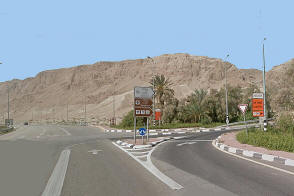
Entrance to Qumran |

Ein Gedi oasis |
We arrived at Masada at 11:30 and spent the next three hours there. Masada is a large natural
rock formation with steep sides and a fairly flat top. It rises nearly 1,500 feet above the Dead Sea
on its east side, with nothing but desert on the other sides. Masada was fortified by King Herod
beginning around 35 B.C. primarily to serve as a place of refuge for himself were his people to
rise against him. It included two palaces for the King, as well as administrative centers,
storehouses, barracks, and an armory.
Masada was seized by an extremist Jewish sect (the Sicarii) in 66 A.D.
as the Jews revolted against Roman rule. They were joined by others
after the Romans captured Jerusalem in 70 A.D. In 73 A.D. a Roman legion
surrounded Masada, built a ramp to allow its seige engines to reach the
walls, and captured the stronghold. The historian Josephus wrote that
all the inhabitants died in a mass murder-suicide pact rather than
endure capture by the Romans.
We took a cable car to the top. It was very hot and there was no shade, but a steady strong wind
provided some relief. We could see already from the cable car that the Roman siege camps, built
with stone walls around them, could still be made out. We gathered for a briefing by Shanee, and
pretty much stayed together through her interesting description (using a model) of how water was
collected and stored in this arid place. After that, we were free to do our own exploring.

Cable car up to Masada |
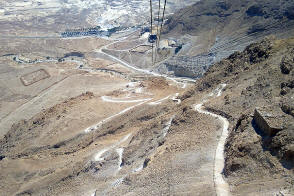
Roman camps (left & center) |

Dead Sea from top |

Briefing atop Masada |
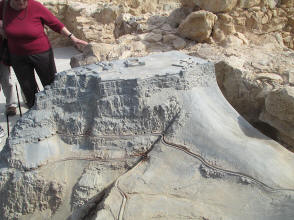
Model with water system |
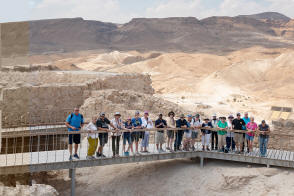
Our group on bridge |
Many of the original buildings had been identified and excavated, and some old walls and columns
had been partially restored (restacked), but as is usually the case with such old ruins, it was hard
to make much of them.

On top of Masada |

Us on Masada |

Roman ramp |
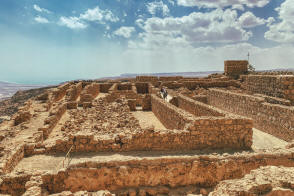
Ruins of north palace (top) |
A big exception here was Herod’s Northern Palace. Because of its
unusual design and three-level construction, even we amateurs could tell what it was and have an
idea of what it must have looked like. We had easy access to the top level of
the palace, and looking over the
edge, we could clearly see the middle level, and even a bit of the bottom level.

Aerial view of all 3 levels |
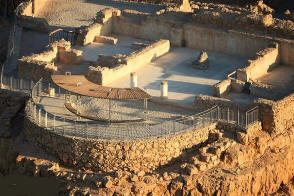
Aerial view of top level
where we stood |

View of 2nd level from top |

Black legs from the Dead Sea |
The time passed quickly and soon we were on our way down in the cable car. On leaving Masada,
we drove north along the Dead Sea and stopped about 2:40 at a beach area for lunch. This was
also a chance for those who wanted to bathe in the super salty water to do so. Many of our group did
but not us. We had read that it could be very dangerous, and in fact, a young man appeared to
suffer an injury as we watched. He had to be helped from the water.
Our group also went into a Dead Sea cosmetics shop at this stop. Each of us had an arm smeared
with mud from the Sea. Then the proprietor removed the mud using a magnet wrapped in a paper
towel. It made our skin feel smooth and moist. Some of our group bought a jar on the spot, only
to discover later that the same jar was sold on Amazon for less that half the price.
We got back to our hotel before 5:00. Dinner was at 6:45.
JERUSALEM: HEZEKIAH'S TUNNEL
The previously postponed visit to
Hezekiah’s Tunnel had been reschedule for tonight, and Darrell was going. (How could he not
when he had seven generations of Hezekiahs in his family?) The 1750-foot tunnel was carved
during the 29-year reign of Judean King Hezekiah (715 and 686 B.C.) to bring water from one
side of the city to the other without being exposed to Assyrian attackers. (Hezekiah also built the
first city wall around the Western Hill. His efforts proved successful. Jerusalem did not fall to the
Assyrians.)
The bus left the hotel at 8:10 and dropped the tunnel group off at the Western Wall Plaza. The
Wall looked very different at night, but it was still quite crowded. There was more of a circus
atmosphere than there had been during the day. Shanee led the group through the ticket office and
down the stairs leading to the tunnel area. There she briefed us on the tunnel layout and the rules for the walk. She then led us down the final stairs into the tunnel.
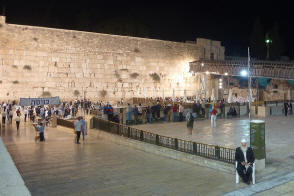
Western Wall at night |
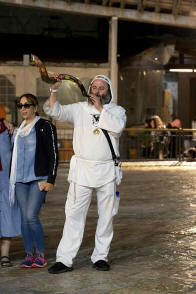
Blowing on a shofar |

Shanee explains the tunnel |
We found ourselves facing the same Western Wall as in the Plaza, though we were now well
below that level. We were in a broad open area, but as we started our walk, the tunnel narrowed.
Sometimes it was only as wide as our shoulders; other times it opened into a broad, two-story
room. It was always high enough for a person of average height to stand upright. The floor was
often wet, but never with as much as half an inch of standing water.

Touching the Western Wall |

Tunnel narrows |
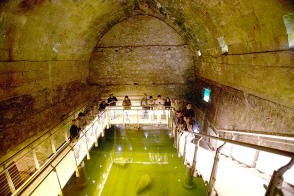
Tunnel widens |
To get out of the tunnel, we had to retrace our steps. That explains why only one group could be in the tunnel at a time. Altogether, we spent about 90 minutes underground. The bus had us back
at the hotel at 10:30. It had been a long day.